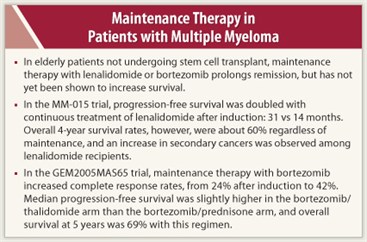The benefit of maintenance therapy in newly diagnosed multiple myeloma patients ineligible for stem cell transplant, such as the elderly, is still debated, though value appears to be emerging, according to studies presented at the 2011 American Society of Hematology (ASH) Annual Meeting.
Maintenance therapy with either lenalidomide (Revlimid) or bortezomib (Velcade) delayed progression in clinical trials. An overall survival advantage was not yet evident, but in the bortezomib trial, median overall survival has not been reached in one arm.
MM-015 Trial
 Italian investigators evaluated lenalidomide in 459 elderly, transplant-ineligible patients, with a median age of 71 years. The final results of the phase III MM-015 trial were presented by Antonio Palumbo, MD, of the University of Turin, Italy.1
Italian investigators evaluated lenalidomide in 459 elderly, transplant-ineligible patients, with a median age of 71 years. The final results of the phase III MM-015 trial were presented by Antonio Palumbo, MD, of the University of Turin, Italy.1
“What is really changing in the treatment paradigm is the concept of continuing treatment, moving from a fixed treatment to one incorporating continuous therapy,” Dr. Palumbo said. “Continuous treatment adds about 10 months of remission duration in elderly patients, and while no survival advantage has been shown, 3-year overall survival projected at 70% is certainly a good outcome.”
MM-015 tested three treatment regimens. Two groups received induction therapy consisting of melphalan, prednisone, and lenalidomide (MPR). Half this group (n = 152) was placed on maintenance therapy with lenalidomide (MPR-R) given on days 1 to 21 every 28 days until progression, while the other half (n = 153) received no continuous therapy (MPR). A third group (n = 154) received only melphalan and prednisone as induction therapy and no maintenance (MP).
The three-drug combination led to significantly more responses, “so MPR is better than MP when toxicity is not a problem…. But maintenance therapy provides the major difference,” Dr. Palumbo said.
“You get a doubling in progression-free survival when you use continuous treatment,” he noted. Lenalidomide maintenance significantly extended progression-free survival, from 14 months with MPR and 13 months with MP to 31 months with MPR-R. The landmark analysis of all patients showed that lenalidomide maintenance resulted in a 66% reduction in progression (P < .001).
“The advantage of maintenance was present in all patients, independent of age, grade, prognosis and so forth,” he noted.
At 41 months median follow-up, however, no impact had been seen on overall survival. At 4 years, overall survival rates were 59% for MPR-R, 58% for MPR, and 58% for MP. These rates are significantly better than the typical 3-year average survival time, he noted, pointing out that a trend toward a survival benefit was observed in the 65- to 75-year-old age group.
The major toxicity was neutropenia (grade 4 in 30% of patients). Grade 4 thrombocytopenia occurred in 5% of patients. “But as far as maintenance is concerned, thrombocytopenia and neutropenia rates were very rare,” he said. “Even in the frail elderly, toxicity is acceptable.”
Increase in Secondary Cancers Observed
The downside of lenalidomide therapy in the study was the increased incidence of secondary cancers, though still rare. There were 12 cases of cancer among patients receiving maintenance lenalidomide, and 10 among patients receiving lenalidomide alone in the induction regimen, compared with 4 among patients who received only melphalan and prednisone. This amounted to incidence rates per 100 patient-years of 3.04 with MPR-R, 2.57 with MPR, and 0.98 with MP.
But Dr. Palumbo argued that this slight risk (about 5%) was far outweighed by lenalidomide’s benefit in delaying progression (about 75%), an opinion seconded by many specialists at the meeting.
Bortezomib-based Maintenance Strategy
 Bortezomib-based maintenance regimens may also optimize myeloma treatment in this group of patients, according to Maria-Victoria Mateos, MD, of the University Hospital of Salamanca, Spain.
Bortezomib-based maintenance regimens may also optimize myeloma treatment in this group of patients, according to Maria-Victoria Mateos, MD, of the University Hospital of Salamanca, Spain.
In the GEM2005MAS65 trial, conducted by the Spanish Myeloma Group, 260 elderly patients (median age 71) received induction therapy with bortezomib, melphalan, and prednisone (VMP) or bortezomib, thalidomide (Thalomid), and prednisone (VTP), after which 178 received one of two possible maintenance regimens: bortezomib plus thalidomide (VT) or bortezomib plus prednisone (VP).2
Maintenance therapy was bortezomib at 1.3 mg/m2 administered on days 1, 4, 8, and 11 every 3 months plus thalidomide at 50 mg/d (VT) or prednisone at 50 mg (VP) every 2 days up to 3 years. The study did not evaluate outcomes in patients who did not receive maintenance.
Response rates were about 80% with either regimen. The current study determined whether maintenance therapy would upgrade these responses and confer a benefit in terms of progression-free and overall survival.
“Toxicity was very low with maintenance,” Dr. Mateos noted. VT was associated with more peripheral neuropathy (9% vs 3%), but in all but one patient this was worsening—not emergent—neuropathy.
Maintenance therapy greatly increased the number of complete responses. For the whole population, after a median of 20 months of maintenance, complete responses increased from 24% after induction to 42%. After induction, complete response rates were similar between VMP and VTP, but slightly more additional complete responses were achieved with VT maintenance (46% vs 39%), Dr. Mateos reported.
At 46 months follow-up, median progression-free survival was slightly higher with VT maintenance—39 vs 32 months with VP—and this was not influenced by the induction regimen. Overall survival has not been reached with VT maintenance, with 69% of patients alive at 5 years and 60% alive after treatment with VP.
But for patients with high-risk cytogenetics (20% of the population), neither maintenance regimen could overcome the poor prognosis. Median progression-free survival was 26 months and median overall survival was 50 months, with no differences seen between the regimens. ■
Disclosure: Dr. Palumbo reported receiving honoraria from Celgene. Dr. Mateos reported receiving honoraria from Millennium Pharmaceuticals, Janssen, and Celgene.
Expert Point of View: Maintenance with Lenalidomide or Bortezomib Prolongs Remission in Elderly Patients with Multiple Myeloma
References
1. Palumbo A, Adam Z, Kropff M, et al: A phase 3 study evaluating the efficacy and safety of lenalidomide combined with melphalan and prednisone followed by continuous lenalidomide maintenance in patients ≥ 65 years with newly diagnosed multiple myeloma: Updated results for patients aged 65 to 75 years enrolled in MM-015. 2011 American Society of Hematology Annual Meeting. Abstract 475. Presented December 12, 2011.
2. Mateos M-V, Oriol A, Teruel A-I, et al: Maintenance therapy with bortezomib plus thalidomide or bortezomib plus prednisone in elderly myeloma patients included in the GEM2005MAS65 Spanish randomized trial. American Society of Hematology Annual Meeting. Abstract 477. Presented December 12, 2011.

 David S. Siegel, MD, PhD, of the John Theurer Cancer Center at Hackensack University Medical Center in New Jersey, commented to The ASCO Post that essentially all patients with multiple myeloma could be candidates for maintenance therapy. “But I don’t know that we have established that maintenance...
David S. Siegel, MD, PhD, of the John Theurer Cancer Center at Hackensack University Medical Center in New Jersey, commented to The ASCO Post that essentially all patients with multiple myeloma could be candidates for maintenance therapy. “But I don’t know that we have established that maintenance...